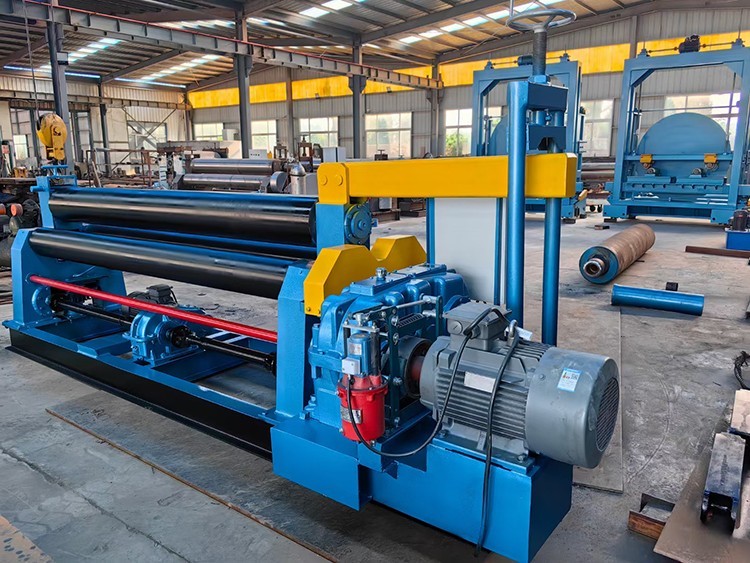When choosing a Two-roller rolling machine, multiple factors need to be considered to ensure that the selected equipment can meet specific processing requirements and working environments. Here are some key selection factors compiled by the Two-roller rolling machine factory:
1. Thickness and material of the board
Sheet thickness: The processing capacity of a Two-roller rolling machine is usually directly related to the sheet thickness it can handle. Therefore, when selecting equipment, the first step is to clarify the thickness range of the sheet metal that needs to be processed and choose the matching model of the Two-roller rolling machine.
Board material: Different materials of boards have different physical and chemical properties, such as hardness, toughness, ductility, etc. These factors will affect the processing effect and efficiency of the rolling machine. Therefore, when selecting equipment, it is necessary to consider the material characteristics of the sheet and choose a suitable Two-roller rolling machine for that material.

2. Curvature and diameter of the rolled plate
Bending radius: The required bending radius of the sheet metal is one of the key factors determining the selection of the two roll bending machine. Different models of bending machines have different arc processing capabilities. Therefore, when selecting equipment, it is necessary to determine the required range of curvature based on actual needs and choose a Two-roller rolling machine that can meet this requirement.
Roll diameter: For sheet metal that needs to be processed into a circular shape, roll diameter is also an important consideration factor. It is necessary to ensure that the selected two roll bending machine has sufficient processing diameter range to meet actual needs.
3. Equipment accuracy and stability
Equipment accuracy: The machining accuracy of the Two-roller rolling machine is crucial for ensuring product quality. When selecting equipment, attention should be paid to its accuracy indicators, such as the parallelism, perpendicularity, coaxiality, etc. of the work roll, to ensure that the selected equipment can meet the requirements of machining accuracy.
Equipment stability: The stability of equipment is directly related to its service life and processing effect. When choosing a Two-roller rolling machine, it is necessary to pay attention to the rationality of its structural design, the reliability of the transmission system, and the wear resistance of the working rolls to ensure that the selected equipment has sufficient stability.
4. Production efficiency and energy consumption
Production efficiency: Production efficiency is one of the important indicators to measure the performance of a Two-roller rolling machine. When selecting equipment, factors such as processing speed, automation level, and ease of operation need to be considered to ensure that the selected equipment can improve production efficiency.
Energy consumption: With the increasing awareness of environmental protection, energy consumption issues are receiving more and more attention. When choosing a Two-roller rolling machine, it is necessary to pay attention to its energy consumption indicators, such as motor power, transmission efficiency, etc., in order to select equipment with lower energy consumption.
5. After sales service and technical support
After sales service: Good after-sales service is the key to ensuring the normal operation of equipment and extending its service life. When choosing a two roll rolling machine, it is necessary to understand the supplier's after-sales service policy, such as warranty period, repair response time, etc.
Technical support: When selecting equipment, it is also necessary to consider the supplier's technical support capabilities. Suppliers who can provide professional technical support and training services can better meet users' usage needs and provide timely solutions when equipment problems occur.
In summary, when choosing a Two-roller rolling machine, it is necessary to comprehensively consider multiple factors such as plate thickness and material, plate curvature and diameter, equipment accuracy and stability, production efficiency and energy consumption, as well as after-sales service and technical support. By comprehensively evaluating these factors, it can be ensured that the selected equipment can meet specific processing requirements and working environments.



 Address:Room 1202, Detaitang Building, No. 118 Huaguang Road, Zhangdian District, Zibo, Shandong
Address:Room 1202, Detaitang Building, No. 118 Huaguang Road, Zhangdian District, Zibo, Shandong WhatsApp:+8615653328535
WhatsApp:+8615653328535 Wechat: +8615965331535
Wechat: +8615965331535  E-mail:zs@sdsmachinery.com
E-mail:zs@sdsmachinery.com